What Is Bracket In Camera
Ane of the most useful techniques in photography is called bracketing – in other words, taking multiple photos of the same bailiwick with different camera settings. Ordinarily, bracketing is about changing your exposure: one photo at the meter'south recommendation, plus one under and ane over. But exposure isn't the only variable at play here. Beneath, this article explains everything you need to know nearly bracketing, including how and when to utilize it to take the best possible photos.
Tabular array of Contents
Why Would Anyone Bracket Photos?
Bracketing means that yous capture a sequence of photos while changing your photographic camera settings from shot to shot. This means you cease up with 2 or more photos of the same scene, with but a couple differences in each one.
Regarding the example of exposure – the most common blazon of bracketing in photography – y'all'll commonly end upward with one photo that is too dark, one that is besides bright, and one with an accurate exposure. But y'all can likewise bracket settings like focus distance, resulting in one photo that is front-focused, ane that is back-focused, and one that is accurate.
At the face up of things, bracketing just takes up infinite and wastes time. Especially if you know exactly what settings you demand for an image, why bother bracketing? Simply in that location are two very real reasons why bracketing is and then helpful in photography.
1. Playing It Safe
Showtime, no matter how certain you are of your camera settings, you might be incorrect. The iii exposures you lot planned – one overexposed, ane underexposed, and one right – won't always turn out that way. Instead, you might capture one underexposed photograph, 1 drastically underexposed photo, and i that is correct.
No one is a perfect guess of exposure in the field, especially in high-contrast low-cal or other tricky conditions. Bracketing, and so, is a way to accept precautions confronting common errors you might brand. Especially for of import images, it's a depression-risk, high-reward technique.
Personally, in my landscape photography, I sometimes find it tricky to expose minor highlights in the sky without blowing them out (i.e., making them completely white). Normally, what I think of as a "cautious exposure" might notwithstanding be overexposed. Bracketing has saved my photos in more than a few such cases. For case, here are three unedited bracketed images:
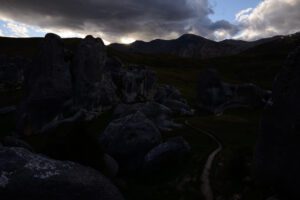
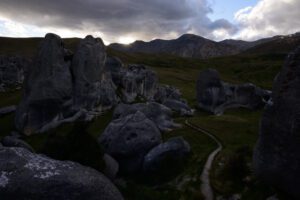
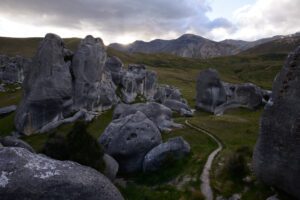
Of the images above, it is really the darkest one on the left which is closest to an "ideal" exposure. The other two have extensive areas of blown highlights in the clouds, and fully recovering them is impossible. Click to run into larger.
ii. Merging Photos
Other times, bracketing is the only manner to capture the photo you have in heed (in combination with some mail-processing later). For example, if you're shooting an ultra-high-contrast scene, one photo but might not cut it. A single "normal" exposure will lead to highlights that are too bright, while also resulting in dark, noisy shadows.
Although you can sometimes get effectually this sort of problem with a graduated ND filter, the more applied option in many cases is to do things digitally. Accept an underexposed photograph and so the highlights look good, plus an overexposed photograph so the shadows are correct. Then, combine the best parts of each photograph into an HDR or luminosity alloy.
You can go beyond a two-photo blend, of form. Three photos are most common. Personally, I don't like blending exposures with more than 2/3 finish of exposure between them, or, at near, 1 stop – because otherwise the transition areas can start to look grainy and odd. So, when I know I demand an HDR, I'one thousand generally shooting three-photo brackets, sometimes more. The images in the previous section make a adept HDR when blended together. Same with the photo below, taken of a fairly high-contrast scene. This is a three-paradigm blend:

Again, though, blending a ready of bracketed images goes across just exposure. We already accept a detailed article on focus stacking, another technique that is very relevant to this topic. Specifically, when you have several shots focused at different points, y'all can combine the best parts of each one into a pivot-sharp result. This besides counts as bracketing, since information technology involves several photos of the same scene while varying camera settings from one to the side by side. It's something a lot of landscape and macro photographers utilise to artificially extend their depth of field.
How to Do Exposure Bracketing
The bodily process of exposure bracketing is like shooting fish in a barrel. In any semi-automatic mode, merely change your exposure compensation from shot to shot. In manual mode, just change whatsoever of the "big three" settings manually: aperture, shutter speed, or ISO. However, as I'll cover in a moment, you lot should pick carefully which to conform if yous desire the all-time results.
Besides, well-nigh every camera today lets you set automatic bracketing with an choice in the menu. When enabled, your camera automatically changes settings from shot to shot rather than making you change it manually. Some cameras only let exposure bracketing, while others have bracketing options for JPEG settings, white balance, and other camera settings. Although bracketing is institute in the menu of most cameras today, yous can ordinarily assign a custom button to access it quicker. Some cameras even have a specific bracketing push button, although that is less common today:
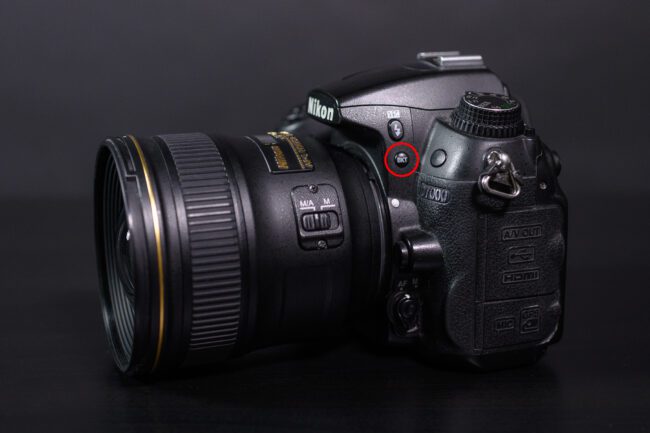
Either mode, I recommend going the camera'south built-in bracketing route. Critically, information technology means y'all can take a bracketed prepare of photos faster than doing things manually. If your camera is prepare to high-speed continuous shooting, for example, you lot might be able to capture a five-image HDR in less than a 2d. If annihilation in your photo is moving, this makes it much more likely that your blend is successful later.
Which Exposure Setting Should Yous Bracket?
A moment ago, I mentioned that information technology is important to cull your bracketing setting carefully. Even though you tin bracket shutter speed, discontinuity, and ISO merely as hands equally one some other, yous'll be happier with some results more than than others.
Aperture: First, discontinuity is often the worst of the 3 settings you can subclass, since it affects depth of field in addition to merely exposure. If you attempt to create an HDR from f/four to f/v.6 to f/8, the consequence may look very odd (with unnatural transitions from blurry to sharp regions). A five-prototype subclass would exist worse. Many of the individual photos volition no longer accept the correct depth of field, making them unusable. Imagine how annoying it would be for your only practiced exposure of a scene to have the wrong depth of field…
ISO: Second, ISO also is not ideal to adjust, since your shots at each ISO volition have different levels of paradigm quality. An HDR from ISO 400, 800, and 1600 shots is not going to give you much improvement over a single ISO 400 image with shadow recovery in post. Don't get me incorrect – bracketing is still a adept thought at higher ISOs if yous want to play information technology safe and avoid blowing out the highlights in tricky situations. Only go along in heed that an HDR from different ISO shots won't be vastly amend than a single image in quality.
Shutter Speed: 3rd is shutter speed – the exposure setting you should always arrange first if possible. Specially if you're shooting from a tripod, and your bailiwick isn't moving, it's a no-brainer; shutter speed is the way to become. Notwithstanding, in scenes with chop-chop-moving subjects and the potential for motion blur, you might not take the flexibility to bracket shutter speed. In those cases, ISO is often the ameliorate choice. I still wouldn't bracket aperture – although maybe you can use a wider aperture for all your photos and so you no longer have a problem bracketing shutter speed.
As a side note, I recommend using either manual or aperture-priority mode (with Machine ISO turned off) for bracketing exposure. Otherwise, you might end up bracketing aperture or ISO unintentionally, when you intended to accommodate shutter speed instead.
How to Do Focus Bracketing
Focus bracketing is easier than exposure bracketing, since at that place is simply one setting nether consideration: focus distance. Hither, your goal unremarkably involves focus stacking the images in post-processing subsequently. Yet, in some cases – like a group photo where yous need everyone precipitous, but don't know exactly where to focus for the best effect – at that place is still an element of playing it safe.
Focus bracketing works all-time when you overlap your depth of field from shot to shot. If your "steps" are too wide, you might end up with a terminal photo that looks very odd: sharp, blurry, sharp, blurry, precipitous, and and so on from the front of the frame to the back.
When you're bracketing focus manually, I recommend taking photos with smaller focus increments than you would look. If you accept fourth dimension, magnify live view then review each photo afterwards to double cheque that the transitions are smooth. Withal, be aware that previews on the photographic camera's rear LCD look very different than full-size images on a large, high-resolution monitor. For optimal results, you might need to exist even more cautious than you'd look.
A lot of cameras today have a born focus stack feature to simplify this process. But focus on your nearest subject, tell the photographic camera how many photos to take, and select a step size. Again, I recommend selecting a lower footstep size than you lot might look, just to exist safety. Information technology'due south too a practiced idea to test this feature ahead of time so you know how to apply it correctly when the photo really matters.

NIKON Z7 + NIKKOR 70-200mm f/iv @ 200mm, ISO 64, 1/20, f/10.0
Other Types of Bracketing
In theory, bracketing can refer to pretty much any variable in photography. You can bracket white balance, JPEG settings, long exposure noise reduction, flash settings, focal length, and much more than.
For example, if you don't know exactly what depth of field you want, information technology might be worth bracketing your aperture merely in case (compensating with shutter speed and then your overall exposure doesn't alter). Or, for Milky way photography, you may accept photos at different ISO and shutter speed settings to get the best combination of racket performance and minimal star trails.
Personally, I even consider limerick to be a part of bracketing, and same with other variables like the fourth dimension of day when you take a picture. Sometimes, you lot'll terminate up taking two or three photos from the same tripod position, but thirty minutes autonomously – one at dark, 1 at blue hour, and 1 at sunrise. (Click on the three images beneath for ane such example.) Some photographers may not consider this to be "bracketing" in the true sense, but I don't really intendance what you call it. Later all, your goal – to hedge your bets and improve the odds of getting a successful prototype – remains the same in either case.
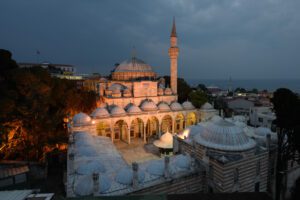
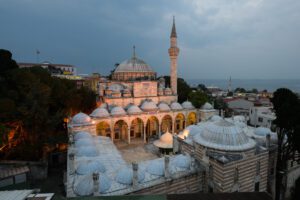
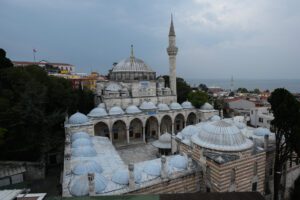
When You Should and Shouldn't Subclass
As useful every bit bracketing is, it won't always be worth doing in the field. Exposure bracketing, peculiarly, doesn't help if you already know exactly what exposure y'all want. It just fills up your retentiveness card faster. On top of that, bracketing can take up actress time if you're trying to work quickly, even if you utilise the photographic camera's congenital-in bracketing characteristic. (Later on all, if your metered exposure is a 15 second shutter speed, bracketing one stop over volition make you lot look some other 30 seconds per shot.)
The biggest reason to avoid bracketing, though, is when y'all're photographing action. For instance, say that you're a wildlife photographer with a bird flying toward your camera. Yous probably have a proficient "safe" exposure in heed that is unlikely to accident out whatsoever details. Bracketing, in this case, ways that you lot're missing 2 of every iii exposures in your sequence – including, quite possibly, the best moment of action – just to reduce the already minor take a chance that your condom exposure is incorrect. That'south not a tradeoff I'd make.
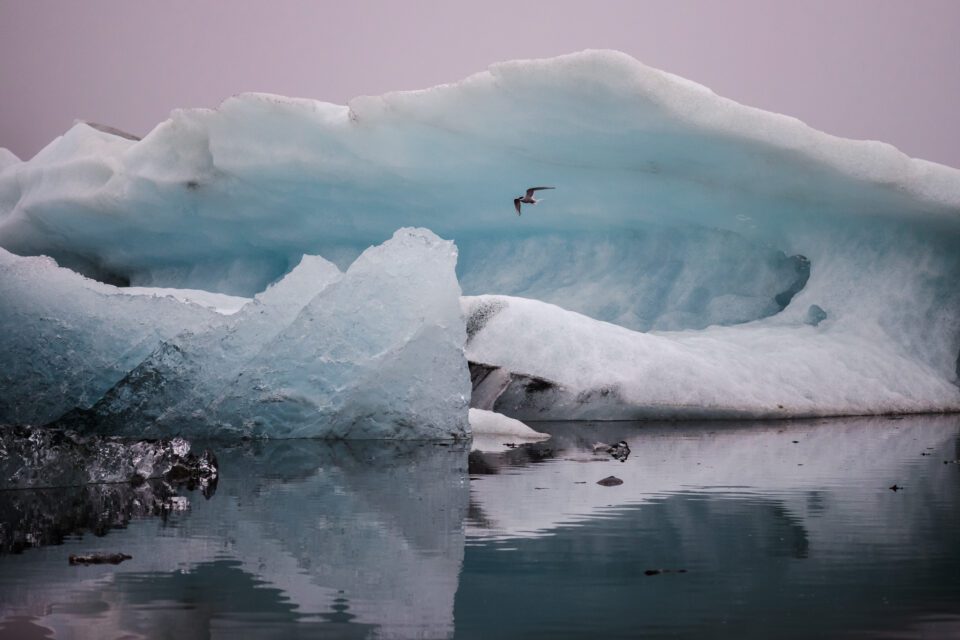
Bracketing here wouldn't have been a proficient idea, since it would take increased my odds of a poor exposure while the bird was at the best location.
Instead, I recommend get out bracketing to situations that are not and then fast-paced. Architectural photography, mural photography, studio photography, and then on – these are all good times to bracket your photos. Besides, in some time-sensitive cases, y'all may wish to enable bracketing after you've already captured what you think is the correct shot. For example, once y'all've taken the wildlife photo you want, it's not a bad idea to enable bracketing and keep taking pictures just in case.
Summary
Although it is non a tool yous should use for every photo, bracketing has the potential to improve your number of keepers significantly under the right weather. As a landscape lensman, I subclass my exposures very oftentimes in tricky conditions, whether to play it safe or to create an HDR later. I also subclass focus for sure images, and – if you'll count information technology as bracketing – I vary my composition and shoot at different times of day for a huge number of important photos.
Bracketing is no substitute for learning how to have good pictures the kickoff time around. But no one gets the perfect exposure every time, and information technology'southward worth a small bit of endeavor to improve your chances of a adept issue. Hopefully, if you rarely or never used bracketing before reading this commodity, you at present have a good idea of when to try it for your own photography.
Source: https://photographylife.com/when-to-use-bracketing
Posted by: murraybehere.blogspot.com

0 Response to "What Is Bracket In Camera"
Post a Comment